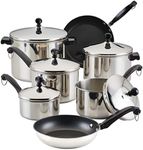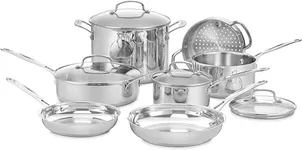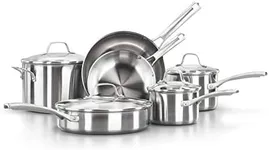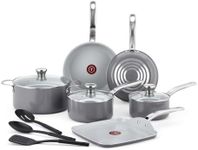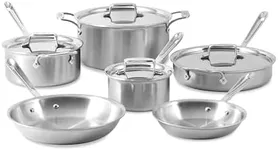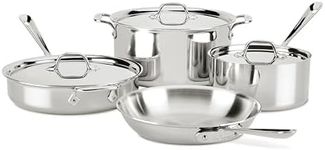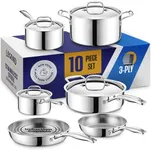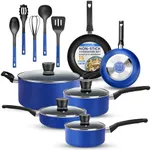Buying Guide for the Best 10 Cookware Sets
Choosing the right cookware set can significantly enhance your cooking experience. The right set will not only make cooking more enjoyable but also ensure that your food is cooked evenly and efficiently. When selecting a cookware set, consider the types of dishes you frequently prepare, the material of the cookware, and the compatibility with your stove. Here are some key specifications to consider when choosing a cookware set.MaterialThe material of the cookware affects heat conductivity, durability, and maintenance. Common materials include stainless steel, non-stick, cast iron, and copper. Stainless steel is durable and resistant to rust but may not conduct heat as well as other materials. Non-stick cookware is easy to clean and great for low-fat cooking but can be prone to scratching. Cast iron retains heat well and is excellent for slow cooking, but it is heavy and requires seasoning. Copper offers excellent heat conductivity but requires regular polishing to maintain its appearance. Choose a material based on your cooking habits and maintenance preferences.
Number of PiecesCookware sets come in various sizes, typically ranging from 5 to 15 pieces. A basic set might include essential items like a frying pan, saucepan, and stockpot, while larger sets may include additional items like sauté pans, steamer inserts, and more. Consider the size of your household and the variety of dishes you cook. If you frequently prepare complex meals, a larger set with more specialized pieces might be beneficial. For simpler cooking needs, a smaller set may suffice.
Heat ConductivityHeat conductivity refers to how evenly and quickly the cookware heats up. Materials like copper and aluminum are excellent conductors of heat, ensuring even cooking and reducing the risk of hot spots. Stainless steel, while durable, is not as good a conductor unless it has an aluminum or copper core. If you want precise temperature control and even cooking, look for cookware with good heat conductivity.
Compatibility with Stove TypeNot all cookware is compatible with every type of stove. For example, induction cooktops require cookware with a magnetic base, such as stainless steel or cast iron. Gas stoves work well with most types of cookware, but you might prefer materials that distribute heat evenly, like copper or aluminum. Electric stoves can work with a variety of materials, but flat-bottomed cookware is ideal for even contact. Ensure the cookware set you choose is compatible with your stove type to avoid any issues.
Oven SafetyIf you plan to use your cookware in the oven, check the maximum temperature it can withstand. Some materials and non-stick coatings have temperature limits. Stainless steel and cast iron are generally safe for high temperatures, while non-stick cookware may have lower limits. Knowing the oven safety of your cookware can expand your cooking options and ensure you don't damage your pots and pans.
Ease of CleaningConsider how easy the cookware is to clean. Non-stick surfaces are generally easier to clean but can be prone to scratching and may require special utensils. Stainless steel can be more challenging to clean if food sticks, but it is dishwasher safe and can handle abrasive cleaning tools. Cast iron requires seasoning and careful cleaning to maintain its non-stick properties. Choose cookware that fits your cleaning preferences and lifestyle.
WeightThe weight of the cookware can affect how easy it is to handle. Heavier cookware, like cast iron, is excellent for heat retention and even cooking but can be cumbersome to lift and move. Lighter cookware, like aluminum, is easier to handle but may not retain heat as well. Consider your strength and comfort level when choosing the weight of your cookware.
Handles and LidsThe design and material of handles and lids can impact the usability of the cookware. Look for handles that are comfortable to grip and stay cool during cooking. Lids should fit securely to retain moisture and heat. Some cookware sets come with glass lids, allowing you to monitor your cooking without lifting the lid. Choose handles and lids that enhance your cooking experience and safety.

